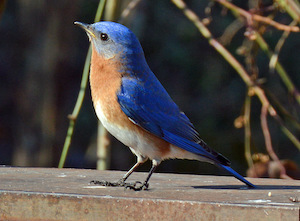
By Terry W. Johnson
The eastern bluebird is one of our most beloved birds. One reason for its popularity is that its beauty can be enjoyed without having to gaze at the bird through a pair of binoculars.
However, the eastern bluebird's stunning beauty belies the fact the species’ migratory behavior is truly perplexing.
Bluebirds can be commonly seen in the Peach State throughout the year. Consequently, one would think bluebirds do not migrate. However, the truth is some do and some don’t. For that reason, ornithologists call them partial migrants. If you think the bluebird's migratory behavior is a bit odd, you are not alone. Even the men and women who study bluebirds are having difficulty unraveling the mysteries swirling about the migratory behavior of this beautiful bird.
For example, biologists have been unable to identify the routes used by bluebirds during migration. Similarly, they have yet to figure out why some bluebirds migrate and others stay at home throughout the winter months. Likewise, we do not understand why some southbound migrants fly past their traditional wintering grounds in the South and wing their way to Bermuda and Cuba.
Here are some of the things we do know. For some unknown reason, some bluebirds hatched in the south and central United States don't migrate at all, preferring to remain on their breeding territories throughout the winter. Others migrate only a few miles.
As a rule though, practically all of the birds raised in southern Canada and the Northeast migrate. The vast majority of these bluebirds spend the winter in the Southeast.
Thousands of eastern bluebirds winter in Georgia each year. Here they intermingle with our resident bluebirds. Consequently, our bluebird population swells significantly during the winter. A study conducted in Florida found that once the northern migrants arrived the local bluebird population within their study area increased 100 percent.
Unlike most of our songbirds, bluebirds migrate during the daytime. Male bluebirds usually arrive on their wintering grounds before females; however, in some years they both arrive about the same time. In spite of this migration pattern, other bluebirds migrate as family groups, and winter together before flying back north as a family.
The departure dates of northern bluebirds vary widely. For example, Minnesota birds leave their breeding grounds anywhere from September to late November or early December. The peak of the fall migration takes place in October. It is thought that the timing of migration may be triggered by changes in the weather, such as the onset of freezing rain and snow.
Bluebirds migrate in flocks. These can number several hundred individuals, though usually the flocks are much smaller. Juvenile bluebirds migrate together, although females and males most often fly south separately. These migratory flocks often stay together throughout the time they remain on their wintering grounds.
As eastern bluebirds move south, the birds tend to fly along the edges of forests and fields. Upon reaching the places where they will spend the winter, the birds can be found scattered across suburban yards, pastures, orchards, brushy fencerows and even in mature hardwood forests.
Most migratory bluebirds leave their breeding grounds in late winter. For that reason, the first bluebirds of the year might arrive home as early as late February, although the arrival of spring migrants peaks in mid-May. Half a continent away, in Massachusetts, folks expect to see their first bluebirds anywhere from late February to March.
When eastern bluebirds return to their summer home, they don't randomly scatter across the countryside. Banding studies have found that from 30–50 percent of the birds return to the same place where they nested the previous year.
Terry W. Johnson is a former Nongame program manager with the Wildlife Resources Division and executive director of The Environmental Resources Network, or TERN, friends group of the division’s Nongame Conservation Section. (Permission is required to reprint this column.) Learn more about TERN, see previous “Out My Backdoor” columns, read Terry’s Backyard Wildlife Connection blog and check out his latest book, “A Journey of Discovery: Monroe County Outdoors.”






